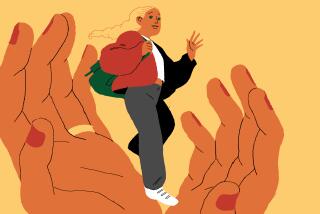Electronic ‘Babies’ Help Teens Learn the Trials of Parenthood
- Share via
OJAI — Jennifer Covey named her baby girl December Snow.
“I’ve just always liked that name,” said the Ojai high school junior as she cuddled the vinyl, electronic “infant” she would mother for the next 48 hours.
But when a persistent December squall interrupted Jennifer’s flag practice, geometry homework and--worst of all--her sleep, the teen-ager’s love affair with the disturbingly lifelike doll started to wane.
“She eats a lot,” Jennifer, 16, wrote in a diary. Other entries: “She eats too much.” “She eats like me.” “How many times will this kid eat?” And, finally: “I’m getting tired.”
Removing the romance from baby care is the point of Kim Hunnicutt’s family life class in Room F-7 at Nordhoff High School.
The four computer-controlled “Baby Think It Over” dolls she hands over to students for two days each come with cute infant carriers, five changes of clothes and a strong dose of reality: They cry at unpredictable intervals and cannot be quieted unless properly cuddled and “fed” by inserting a key into a monitoring device in the doll’s back.
These are the first Baby Think It Over dolls being used in Ventura County classrooms--little screaming machines that sex education teachers here and statewide are turning to increasingly in hopes of discouraging teen-age students from becoming parents too early.
The dolls have been on the market for two years and educators nationwide are already praising their effectiveness. Earlier attempts to teach students responsibility by giving them a raw egg or a sack of flour to watch over pale in comparison to dolls equipped with a high-pitched, human newborn wail, teachers say.
“I think it’s a healthy thing for them so they have just a small taste of what life will bring them,” Hunnicutt said. “And hopefully, they will plan accordingly.”
Hunnicutt’s students began receiving the dolls this week. The babies will cry, she said, any time they are placed in the wrong position, are handled too roughly or are hungry.
And sometimes--just like the real thing--the dolls cry for no reason at all, Hunnicutt said. But that does not mean students can just shove them in a locker, she said.
An electronic box on the baby’s back registers neglect, such as leaving the doll to cry more than five minutes, Hunnicutt warned the class. And neglectful parents will receive a lower grade, she told them.
Finally, any student who damages a baby will have to pay the $250 replacement cost, she said. Then Hunnicutt handed out mock birth certificates.
Jennifer was one of four girls who won a lottery to be the first to take the dolls home. Cheri Hays, 17, named her baby boy Michael Austin. Amanda Kennerly, also 17, preferred the name Dominic for her son.
And 18-year-old Melissa Edwards named her infant girl Haley. There are a handful of boys in Hunnicutt’s class, and they will become parents as well, but none volunteered to be among the first group.
As Jennifer and the other students left Hunnicutt’s room with school-furnished babies, strollers, diaper bags and infant carriers in tow, they got long stares from other pupils.
Knots of girls quickly gathered around them.
“Did you get a girl?” Terra Clement, 16, asked her friend Jennifer during the lunch break. “Oooh, she’s so cute. What’s her name?”
The honeymoon was short-lived for most of the girls. By 12:37 a.m. that night, Melissa Edwards awoke to feed Haley and had this comment for her diary: “I realized my baby is loud and hard to feed. I am very tired right now.”
And on Amanda’s second night as a parent, her “colicky” baby woke every 20 minutes. In a follow-up essay on the experience, a fatigued Amanda wrote this:
“I learned that you devote your whole life to the baby and your freedom is taken away. . . . It did not change my mind on having a baby. But I had decided to wait for a couple of years.”
Certainly the dolls have limitations, said Sheila Oium, national sales manager for the San Diego-based Baby Think It Over Inc. They do not soil their diapers, spit up or move like real babies.
“We don’t want to get too close to the real thing,” Oium said. “We might do away with parenting altogether. You have to save some surprises.”
But the dolls are lifelike enough to teach students that having a baby can put a big-time crimp in a teen-ager’s social life.
“They get a lot of attention with the babies at school,” Oium said. “But there is no audience at night when they have to get up. And most of them come to the conclusion that it’s not worth it.”
Teen-age pregnancy is not a significant problem at Nordhoff High, Hunnicutt said. In the four years she has been teaching there, she has known only one or two students who dropped out to have babies, she said.
Still, teen-agers need to know what’s ahead, Hunnicutt said.
“Amanda Kennerly couldn’t wait to give that baby up,” she said. “The grimace told it all.”
More to Read
Sign up for Essential California
The most important California stories and recommendations in your inbox every morning.
You may occasionally receive promotional content from the Los Angeles Times.














